Squat (exercise)
A squat is a strength exercise in which the trainee lowers their hips from a standing position and then stands back up. During the descent of a squat, the hip and knee joints flex while the ankle joint dorsiflexes; conversely the hip and knee joints extend and the ankle joint plantarflexes when standing up.
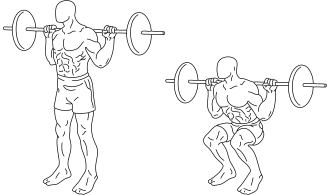

Squats are considered a vital exercise for increasing the strength and size of the lower body muscles as well as developing core strength. The primary agonist muscles used during the squat are the quadriceps femoris, the adductor magnus, and the gluteus maximus.[1] The squat also isometrically uses the erector spinae and the abdominal muscles, among others.[2]
The squat is one of the three lifts in the strength sport of powerlifting, together with the deadlift and the bench press. It is also considered a staple exercise in many popular recreational exercise programs.
Form
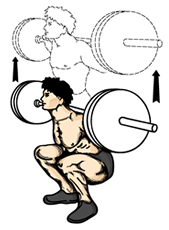
The movement begins from a standing position. Weight is often added; typically in the form of a loaded barbell but dumbbells and kettlebells may also be used. When a barbell is used, it may be braced across the upper trapezius muscle, termed a high bar squat, or held lower across the rear deltoids, termed a low bar squat.[3] The movement is initiated by moving the hips back and bending the knees and hips to lower the torso and accompanying weight, then returning to the upright position.
Squats can be performed to varying depths. The competition standard is for the crease of the hip (top surface of the leg at the hip joint) to fall below the top of the knee;[4] this is colloquially known as "parallel" depth.[5] Confusingly, many other definitions for "parallel" depth abound, none of which represents the standard in organized powerlifting. From shallowest to deepest, these other standards are: bottom of hamstring parallel to the ground;[6] the hip joint itself below the top of the knee, or femur parallel to the floor;[7] and the top of the upper thigh (i.e., top of the quadriceps) below the top of the knee.[8] Squatting below parallel qualifies a squat as deep while squatting above it qualifies as shallow.[3] Some authorities caution against deep squats;[9] though the forces on the ACL and PCL decrease at high flexion, compressive forces on the menisci and articular cartilages in the knee peak at these same high angles.[10] This makes the relative safety of deep versus shallow squats difficult to determine.
As the body descends, the hips and knees undergo flexion, the ankle extends (dorsiflexes) and muscles around the joint contract eccentrically, reaching maximal contraction at the bottom of the movement while slowing and reversing descent. The muscles around the hips provide the power out of the bottom. If the knees slide forward or cave in then tension is taken from the hamstrings, hindering power on the ascent. Returning to vertical contracts the muscles concentrically, and the hips and knees undergo extension while the ankle plantarflexes.[3]
Common errors of squat form include descending too rapidly and flexing the torso too far forward. Rapid descent risks being unable to complete the lift or causing injury. This occurs when the descent causes the squatting muscles to relax and tightness at the bottom is lost as a result. Over-flexing the torso greatly increases the forces exerted on the lower back, risking a spinal disc herniation.[3] Another error is when the knee is not aligned with the direction of the toes, entering a valgus position, which can adversely stress the knee joint. Another error is the raising of heels off the floor, which reduces the contribution of the gluteus muscles.[11][12]

Muscles used
Agonist muscles[13]
- Quadriceps femoris
- Gluteus maximus
- Adductor magnus
- Soleus
Stabilizing muscles
- Erector spinae
- Rectus abdominis
- Internal and external obliques
- Hamstrings
- Gluteus medius and minimus
- Gastrocnemius
Equipment
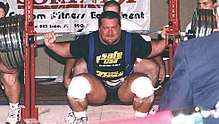
Various types of equipment can be used to perform squats.
A power cage can be used to reduce risk of injury and eliminate the need for a spotting partner. By putting the bar on a track, the Smith machine reduces the role of hip movement in the squat and in this sense resembles a leg press.[14] The monolift rack allows an athlete to perform a squat without having to take a couple of steps back with weight on as opposed to conventional racks. Not many powerlifting federations allow monolift in competitions (WPO, GPC, IPO).
Other equipment used can include a weight lifting belt to support the torso and boards to wedge beneath the ankles to improve stability and allow a deeper squat (weightlifting shoes also have wooden wedges built into the sole to achieve the same effect). Wrist straps are another piece of recommended equipment; they support the wrist and help to keep it in a straightened position. They should be wrapped around the wrist, above and below the joint, thus limiting movement of the joint. Heel wedges and related equipment are discouraged by some as they are thought to worsen form over the long term.[15] The barbell can also be cushioned with a special padded sleeve.
Variants

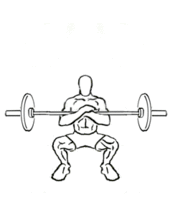

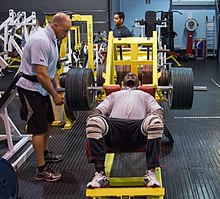
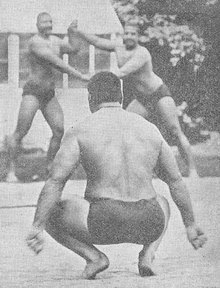

The squat has a number of variants, some of which can be combined:
Barbell
- Back squat – the bar is held on the back of the body upon the upper trapezius muscle, near to the base of the neck. Alternatively, it may be held lower across the upper back and rear deltoids. In powerlifting the barbell is often held in a lower position in order to create a lever advantage, while in weightlifting it is often held in a higher position which produces a posture closer to that of the clean and jerk. These variations are called low bar (or powerlifting squat) and high bar (or Olympic squat), respectively.
- Sumo squat – A variation of the back squat where the feet are placed slightly wider than shoulder width apart and the feet pointed outwards.
- Box squat – at the bottom of the motion the squatter will sit down on a bench or other type of support then rise again. The box squat is commonly utilized by powerlifters to train the squat.
- Front squat – the barbell is held in front of the body across the clavicles and deltoids in either a clean grip, as is used in weightlifting, or with the arms crossed and hands placed on top of the barbell. In addition to the muscles used in the back squat, the front squat also uses muscles of the upper back such as the trapezius to support the bar.[16]
- Hack squat – the barbell is held in the hands just behind the legs; this exercise was first known as Hacke (heel) in Germany.[17] According to European strength sports expert and Germanist Emmanuel Legeard this name was derived from the original form of the exercise where the heels were joined. The hack squat was thus a squat performed the way Prussian soldiers used to click their heels ("Hacken zusammen").[18] The hack squat was popularized in the English-speaking countries by early 1900s wrestler, George Hackenschmidt. It is also called a rear deadlift. It is different from the hack squat performed with the use of a squat machine.[19]
- Overhead squat – the barbell is held overhead in a wide-arm snatch grip; however, it is also possible to use a closer grip if balance allows.
- Zercher squat – the barbell is held in the crooks of the arms, on the inside of the elbow. One method of performing this is to deadlift the barbell, hold it against the thighs, squat into the lower portion of the squat, and then hold the bar on the thighs as you position the crook of your arm under the bar and then stand up. This sequence is reversed once the desired number of repetitions has been performed. Named after Ed Zercher, a 1930s strongman.
- Deep knee bend on toes - it is similar to a normal back squat only the lifter is positioned on their forefeet and toes, with their heels raised, throughout the repetition. Usually, the weight used is not more than moderate in comparison to a flat footed, heavy back squat.
- Loaded squat jump - the barbell is positioned similarly to a back squat. The exerciser squats down, before moving upwards into a jump, and then landing in approximately the same position. The loaded squat jump is a form of loaded plyometric exercise used to increase explosive power. Variations of this exercise may involve the use of a trap bar or dumbbells.
Lunge
- Split squat – an assisted one-legged squat where the non-lifting leg is rested on the ground a few steps behind the lifter, as if it were a static lunge.
- Bulgarian split squat – performed similarly to a split squat, but the foot of the non-lifting leg is rested on a platform behind the lifter.
Other
- Belt squat – is an exercise performed the same as other squat variations except the weight is attached to a hip belt i.e. a dip belt
- Goblet squat – a squat performed while holding a kettlebell next to one's chest and abdomen with both hands.
- Smith squat – a squat using a Smith machine.
- Machine hack squat – using a squat machine.[19]
- Trap bar squat – a trap bar is held in the hands while squats are performed. More commonly referred to as "trap bar deadlifts."
- Monolift squat – a squat using a monolift rack.
- Anderson Squat (aka Pin Squat, Bottoms Up Squat) – starting the squat from the bottom position.[20]
Bodyweight
- Bodyweight squat – done with no weight or barbell, often at higher repetitions than other variants.
- Overhead squat – a non-weight bearing variation of the squat exercise, with the hands facing each other overhead, biceps aligned with the ears, and feet hip-width apart. This exercise is a predictor of total-body flexibility, mobility, and possible lower body dysfunction.
- Hindu squat – also called a baithak, or a deep knee bend on toes. It is performed without additional weight, and body weight placed on the forefeet and toes with the heels raised throughout; during the movement the knees track far past the toes. The baithak was a staple exercise of ancient Indian wrestlers. It was also used by Bruce Lee in his training regime.[21] It may also be performed with the hands resting on an upturned club or the back of a chair.
- Jump squat – a plyometrics exercise where the squatter engages in a rapid eccentric contraction and jumps forcefully off the floor at the top of the range of motion.
- Pistol squat – a bodyweight single leg squat done to full depth, while the other leg is extended off the floor. Sometimes dumbbells, kettlebells or medicine balls are added for resistance.
- Shrimp squat – also called the flamingo squat, a version of the pistols squat where instead of extending the non-working leg out in front, it is bent and placed behind the working leg while squatting, perhaps held behind in a hand.[22]
- Jockey squat - a half-squat, performed by being balanced on the forefeet throughout the repetition, with fingertips touching across the chest. This squat can be performed quickly and in high repetitions.
- Sissy squat – the knees travel over the toes, stretching the quadriceps and the body leans backwards. Can be done in a special sissy squat machine, and can also be weighted.[23][24][25]
Injury considerations
Although the squat has long been a basic element of weight training, it has not been without controversy over its safety. Some trainers allege that squats are associated with injuries to the lumbar spine and knees.[26] Others, however, continue to advocate the squat as one of the best exercises for building muscle and strength. Some coaches maintain that incomplete squats (those terminating above parallel) are both less effective and more likely to cause injury[2] than a full squat (terminating with hips at or below knee level). A 2013 review concluded that deep squats performed with proper technique do not lead to increased rates of degenerative knee injuries and are an effective exercise. The same review also concluded that shallower squats may lead to degeneration in the lumbar spine and knees in the long-term.[27]
Squats used in physical therapy
Squats can be used for some rehabilitative activities because they hone stability without excessive compression on the tibiofemoral joint and anterior cruciate ligament.[28]
Deeper squats are associated with higher compressive loads on patellofemoral joint[28] and it is possible that people who suffer from pain in this joint cannot squat at increased depths. For some knee rehabilitation activities, patients might feel more comfortable with knee flexion between 0 and 50 degrees because it places less force compared to deeper depths. Another study shows that decline squats at angles higher than 16 degrees may not be beneficial for the knee and fails to decrease calf tension.[29] Other studies have indicated that the best squat to hone quadriceps, without inflaming the patellofemoral joint, occurs between 0 and 50 degrees.[28]
Combining single-limb squats and decline angles have been used to rehabilitate knee extensors.[29] Conducting squats at a declined angle allows the knee to flex despite possible pain or lack of mobilization in the ankle.[29] If therapists are looking to focus on the knee during squats, one study shows that doing single-limb squats at a 16 degree decline angle has the greatest activation of the knee extensors without placing excessive pressure on the ankles.[29] This same study also found that a 24 degree decline angle can be used to strengthen ankles and knee extensors.[29]
Different Sets For Squats
Forced repetitions are used when training until failure. They are completed by completing an additional 2-4 reps (assisted) at the end of the set.[30] Partial repetitions are also used in order to maintain a constant period of tension in order to promote hypertrophy.[31] Lastly, drop-sets are an intense workout done in at the end of a set which runs until failure and continues with a lower weight without rest. [32]
World records
- The world record for the biggest equipped squat, with a multi-ply squat suit and knee wraps, is 579.96 kg (1278.6 lb) performed by Nathan Baptist at the UPA Utah Kick Off Meet on the 2nd of January 2020.[33]
- The raw world record with knee wraps is 525 kg (1157 lb) performed by Vlad Alhazov on 23 December 2018.[34]
- The raw world record without knee wraps belongs to Ray Williams who lifted 490 kg (1080 lb) in March 2019, at the Arnold Classic in Columbus, Ohio.[35]
- The women world record is held by American Becca Swanson with a recorded competition lifted 387.0 kg (854 lb).[36]
- The most squats with 130 kg in two minutes was Netherlands woman Maria Strik. She squatted a weight of 130 kg, 29 times within two minutes.[37]
- The most bodyweight squats performed in one hour is 4,708 by Paddy Doyle (UK) on November 2007.[38]
- The most bodyweight sumo squats in one hour is 5,135, and was achieved by Dr. Thienna Ho (Vietnam) on December 2007.[39]
- The most pistol squats in one minute (male) is 52, and was achieved by William Rauhaus (Germany) in Bad Aibling, Germany, on 27 July 2016.[40]
- Silvio Sabba from Italy has:
- the most squats in one minute carrying a 60 lb pack: 47 on June 2016[41] (the previous was 44 by Paddy Doyle)[42]
- the most squats in one minute carrying an 80 lb pack: 42 on July 2016[43]
- the most pistol squats on a scaffold pole in one minute: 30 on October 2013[44]
- the most pistol squats on an American football in one minute: 23 on July 2015[45]
See also
References
- "BB Squat". ExRx. Retrieved 29 May 2019.
- Rippetoe M (2007). Starting Strength: Basic Barbell Training, p.8. The Aasgaard Company. p. 320. ISBN 978-0-9768054-2-7.
- Brown SP (2000). Introduction to exercise science. Lippincott Wims & Wilkins. pp. 280–1. ISBN 0-683-30280-9.
- Technical Rules Book 2013 Archived 19 March 2013 at the Wayback Machine. International Powerlifting Federation. powerlifting-ipf.com
- Hanna, Wade (March 2002) Squat depth clarified. USA Powerlifting Online Newsletter. Usapowerlifting.com. Retrieved on 2013-08-05.
- Hi- and Low-bar Squatting. Home.comcast.net. Retrieved on 2013-08-05.
- 6 Things I Really Dislike. T Nation. Retrieved on 2013-08-05.
- A Closer Look at the Parallel Squat. Bigger Faster Stronger, March/April 2008, pp. 36–38.
- Kellis E, Arambatzi F, Papadopoulos C (October 2005). "Effects of load on ground reaction force and lower limb kinematics during concentric squats". Journal of Sports Sciences. 23 (10): 1045–55. doi:10.1080/02640410400022094. PMID 16194981.
- Clarkson, HM, and Gilewich, GB (1999) Musculoskeletal Assessment: Joint Range Of Motion And Manual Muscle Strength. Baltimore, MD: Williams and Wilkins, p. 374, ISBN 0683303848.
- "Squat". lift.net.
- Sandvik E. "The 11 Worst Squat Mistakes". T NATION. Retrieved 7 April 2018.
- "BB Squat". ExRx. Retrieved 29 May 2019.
- Cornacchia, pp. 121, 125.
- McRobert S (1999). The Insider's Tell-All Handbook on Weight-Lifting Technique. CS Publishing. ISBN 9963-616-03-8.
- "Front Squat". ExRx. Retrieved 30 May 2019.
- Hackenschmidt, George (1908). The Way To Live in Health and Physical Fitness. York. p. 70.
- Legeard, Emmanuel (2008). Les Fondamentaux. Paris. p. 218. ISBN 978-2851806789.
- "Machine Hack Squat". bodybuilding.com. Retrieved 15 July 2020.
- "Anderson Squat – How It Benefits Your Training". Barbend.com. Retrieved 15 July 2020.
- Lee, Bruce,'Preliminaries' in The Tao of Jeet Kune Do, California: Ohara Publications, 1975, p.29
- Periodic Table of Bodyweight Exercises with Clickable Videos. Strength.stack52.com. Retrieved on 2015-04-24.
- Mark Dutton (2020). Dutton's Orthopaedic: Examination, Evaluation and Intervention, Fifth Edition. McGraw Hill Professional. p. 1009. ISBN 9781260440119.
- "Weighted sissy squat". bodybuilding.com. Retrieved 11 May 2020.
- "Sissy Squat Video Guide". Muscle and Strength. Retrieved 11 May 2020.
- Cornacchia, p. 120.
- Hartmann H, Wirth K, Klusemann M (October 2013). "Analysis of the load on the knee joint and vertebral column with changes in squatting depth and weight load". Sports Medicine. 43 (10): 993–1008. doi:10.1007/s40279-013-0073-6. PMID 23821469.
- Jaberzadeh S, Yeo D, Zoghi M (September 2016). "The Effect of Altering Knee Position and Squat Depth on VMO : VL EMG Ratio During Squat Exercises". Physiotherapy Research International. 21 (3): 164–173. doi:10.1002/pri.1631. PMID 25962352.
- Richards J (2008). "A Biomechanical Investigation of a Single-Limb Squat: Implications for Lower Extremity Rehabilitation Exercise". Journal of Athletic Training. 43 (5): 477–482. doi:10.4085/1062-6050-43.5.477. PMC 2547867. PMID 18833310.
- Strength training : methods, health benefits and doping. Ferraresi, Cleber,, Rodrigues Bertucci, Danilo. Hauppauge, New York. 2016. ISBN 978-1-63484-157-3. OCLC 933581166.CS1 maint: others (link)
- Strength training : methods, health benefits and doping. Ferraresi, Cleber,, Rodrigues Bertucci, Danilo. Hauppauge, New York. 2016. ISBN 978-1-63484-157-3. OCLC 933581166.CS1 maint: others (link)
- "LPC Library Off-Campus Database Access Login". Missing or empty
|url=(help) - . Multi-ply Ranking. Retrieved 2020-07-16.
- "Powerlifting Watch".
- https://barbend.com/ray-williams-squats-490kg/
- https://irishstrongman.com/6183/
- Glenday C (2013). 2013 Guinness World Records Limited. pp. 104. ISBN 978-1-908843-15-9.
- "Most squats in one hour". Guinness World Records.
- "Most sumo squats in one hour". Guinness World Records.
- "Most squats in one minute (single leg)". Guinness World Records. Retrieved 16 March 2020.
- "Most squats in one minute carrying a 60 lb pack". Guinness World Records.
- "Watch 'World's Fittest Man' Paddy Doyle reclaim record for longest plank while carrying a 100-lb pack". Guinness World Records.
- "Most squats in one minute carrying an 80 lb pack". Guinness World Records.
- "Most pistol squats on a scaffold pole in one minute". Guinness World Records.
- "Most pistol squats on an american football ball in one minute". Guinness World Records.
Bibliography
- Cornacchia L, Bompa TO, Di Pasquale MG, Di Pasquale M (2003). Serious strength training. Champaign, IL: Human Kinetics. ISBN 0-7360-4266-0.
| Wikimedia Commons has media related to Squat (exercise). |